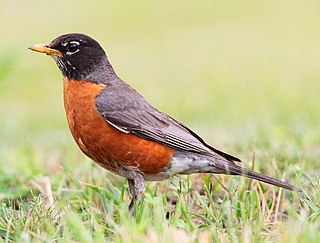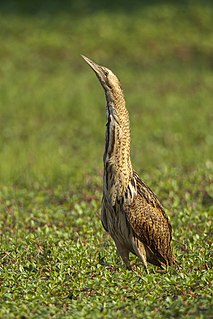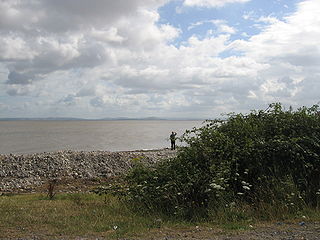Related Research Articles

The American robin is a migratory bird of the true thrush genus and Turdidae, the wider thrush family. It is named after the European robin because of its reddish-orange breast, though the two species are not closely related, with the European robin belonging to the Old World flycatcher family. The American robin is widely distributed throughout North America, wintering from southern Canada to central Mexico and along the Pacific Coast. It is the state bird of Connecticut, Michigan, and Wisconsin.

Birdwatching, or birding, is the observing of birds, either as a recreational activity or as a form of citizen science. A birdwatcher may observe by using their naked eye, by using a visual enhancement device like binoculars or a telescope, by listening for bird sounds, or by watching public webcams.

The Eurasian bittern or great bittern is a wading bird in the bittern subfamily (Botaurinae) of the heron family Ardeidae. There are two subspecies, the northern race breeding in parts of Europe and across the Palearctic, as well as on the northern coast of Africa, while the southern race is endemic to parts of southern Africa. It is a secretive bird, seldom seen in the open as it prefers to skulk in reed beds and thick vegetation near water bodies. Its presence is apparent in the spring, when the booming call of the male during the breeding season can be heard. It feeds on fish, small mammals, fledgling birds, amphibians, crustaceans and insects.

The barn owl is the most widely distributed species of owl in the world and one of the most widespread of all species of birds, being found almost everywhere except for the polar and desert regions, Asia north of the Himalayas, most of Indonesia, and some Pacific Islands. It is also known as the common barn owl, to distinguish it from the other species in its family, Tytonidae, which forms one of the two main lineages of living owls, the other being the typical owls (Strigidae).

Bridgwater Bay is on the Bristol Channel, 5 kilometres (3.1 mi) north of Bridgwater in Somerset, England at the mouth of the River Parrett and the end of the River Parrett Trail. It stretches from Minehead at the southwestern end of the bay to Brean Down in the north. The area consists of large areas of mudflats, saltmarsh, sandflats and shingle ridges, some of which are vegetated. It has been designated as a Site of Special Scientific Interest (SSSI) covering an area of 3,574.1 hectares since 1989, and is designated as a wetland of international importance under the Ramsar Convention. The risks to wildlife are highlighted in the local Oil Spill Contingency Plan.

The little egret is a species of small heron in the family Ardeidae. It is a white bird with a slender black beak, long black legs and, in the western race, yellow feet. As an aquatic bird, it feeds in shallow water and on land, consuming a variety of small creatures. It breeds colonially, often with other species of water birds, making a platform nest of sticks in a tree, bush or reed bed. A clutch of three to five bluish-green eggs is laid and incubated by both parents for about three weeks. The young fledge at about six weeks of age.

The domestic turkey is a large fowl, one of the two species in the genus Meleagris and the same species as the wild turkey. Although turkey domestication was thought to have occurred in central Mesoamerica at least 2,000 years ago, recent research suggests a possible second domestication event in the area that is now the southwestern United States between 200 BC and AD 500. However, all of the main domestic turkey varieties today descend from the turkey raised in central Mexico that was subsequently imported into Europe by the Spanish in the 16th century.

Birds of a Feather is a British sitcom originally broadcast on BBC One from 16 October 1989 to 24 December 1998, then revived on ITV from 2 January 2014 to 24 December 2020. The series stars Pauline Quirke and Linda Robson, with Lesley Joseph, created by Laurence Marks and Maurice Gran, who also wrote many of the episodes.
A big year is a personal challenge or an informal competition among birders who attempt to identify as many species of birds as possible by sight or sound, within a single calendar year and within a specific geographic area. Popularized in North America, big years are commonly carried out within a single U.S. state or Canadian province, or within larger areas such as the Lower 48 contiguous states, within the official American Birding Association (ABA) area, or sometimes the entire globe. The ABA big year record of 840 species was set by John Weigel of Australia in 2019. The big year world record of 6,852 species was set in 2016 by Arjan Dwarshuis of the Netherlands.

Cemlyn Bay is a bay on the northwest coast of Anglesey, North Wales, approximately 2.5 km west of Wylfa nuclear power station, within the community of Cylch-y-Garn.
Richard Millington is a British birder and bird artist. He lives in Cley-next-the-Sea, Norfolk. He does not appear to be with his wife Hazel.
The British Birds Rarities Committee (BBRC), established in 1959, is the national bird rarities committee for Britain. It assesses claimed sightings of bird species that are rarely seen in Britain, based on descriptions, photographs and video recordings submitted by observers. Its findings are published in an annual report in the journal British Birds.
Two species of bee-eater have occurred as wild visitors to Britain, with a third species having occurred as an escape from captivity.

Cranes are large, long-legged and long-necked birds of the order Gruiformes. Two species occur as wild birds in Great Britain: the common crane, a scarce migrant and very localised breeding resident currently being reintroduced to the country, and the sandhill crane, an extreme vagrant from North America. A third species, the demoiselle crane, has been recorded on a number of occasions, but these birds have not generally been accepted as being of wild origin.

In the United States, the eagle feather law provides many exceptions to federal wildlife laws regarding eagles and other migratory birds to enable Native Americans to continue their traditional, spiritual and cultural practices.

The red-eared firetail, also known as the boorin, is a small finch-like species of bird. It occurs in dense wetland vegetation of coastal to sub-coastal regions in Southwest Australia. Its appearance is considered appealing, with white spots, black barring and vivid crimson marks at the ear and upper tail. Red-eared firetails are usually only glimpsed briefly, if at all, as they move rapidly and discreetly through their habitat. Most observations occur when their soft voice is heard, or in flight when flushed from the dense scrub. Males and females are similar in colouring and bond as lifelong pairs that occupy a territory centred on their roosting and brooding nest site. The species occupy a similar ecological niche to the beautiful firetail Stagonopleura bella found in the east of Australia, although unlike other species of the genus they only occasionally group together and are almost never seen in large flocks.
The Welsh Ornithological Society is an organisation which promotes the study and conservation of birds in Wales. Each year it organises a conference and publishes two issues of the journal Welsh Birds, one of which contains the Welsh Bird Report. It was founded on 26 March 1988 at a conference in Aberystwyth. It now has about 250 members. The television presenter and author Iolo Williams has been the society's president since November 2009.

Hawaiian feather helmets, known as mahiole in the Hawaiian language, were worn with feather cloaks. These were symbols of the highest rank reserved for the men of the aliʻi, the chiefly class of Hawaii. There are examples of this traditional headgear in museums around the world. At least sixteen of these helmets were collected during the voyages of Captain Cook. These helmets are made from a woven frame structure decorated with bird feathers and are examples of fine featherwork techniques. One of these helmets was included in a painting of Cook's death by Johann Zoffany.

Godrevy Head to St Agnes is a coastal Site of Special Scientific Interest (SSSI) in north Cornwall, England], noted for both its biological and geological characteristics. A number of rare and scarce plant species can be found on the site, along with many breeding seabirds.

The monk parakeet, also known as the Quaker parrot, is a species of true parrot in the family Psittacidae. It is a small, bright-green parrot with a greyish breast and greenish-yellow abdomen. Its average lifespan is 20–30 years. It originates from the temperate to subtropical areas of Argentina and the surrounding countries in South America. Self-sustaining feral populations occur in many places, mainly in North America and Europe.
References
- ↑ Ancestry.com. England & Wales, Civil Registration Birth Index, 1916-2007 [database on-line]. Provo, UT, USA: Ancestry.com Operations Inc, 2008.
- ↑ Marinne MacDonald (27 January 1993). "Twitcher devotes his life to an obsessive flight of fancy". The Independent. Retrieved 4 December 2011.
- ↑ May, Derwent (12 September 2009). "Feather report: The Ultimate Site Guide to Scarcer British Birds". The Times . Retrieved 24 February 2011.
- ↑ Sam Wollaston (2 November 2010). "TV review: The Trip, Coppers, The Little House, Twitchers: A Very British Obsession, Extreme Fishing with Robson Green". The Guardian. Retrieved 4 December 2011.
- ↑ Adam Lusher (25 March 2001). "Feathers fly in fight to be top twitcher". Daily Telegraph. Retrieved 4 December 2011.